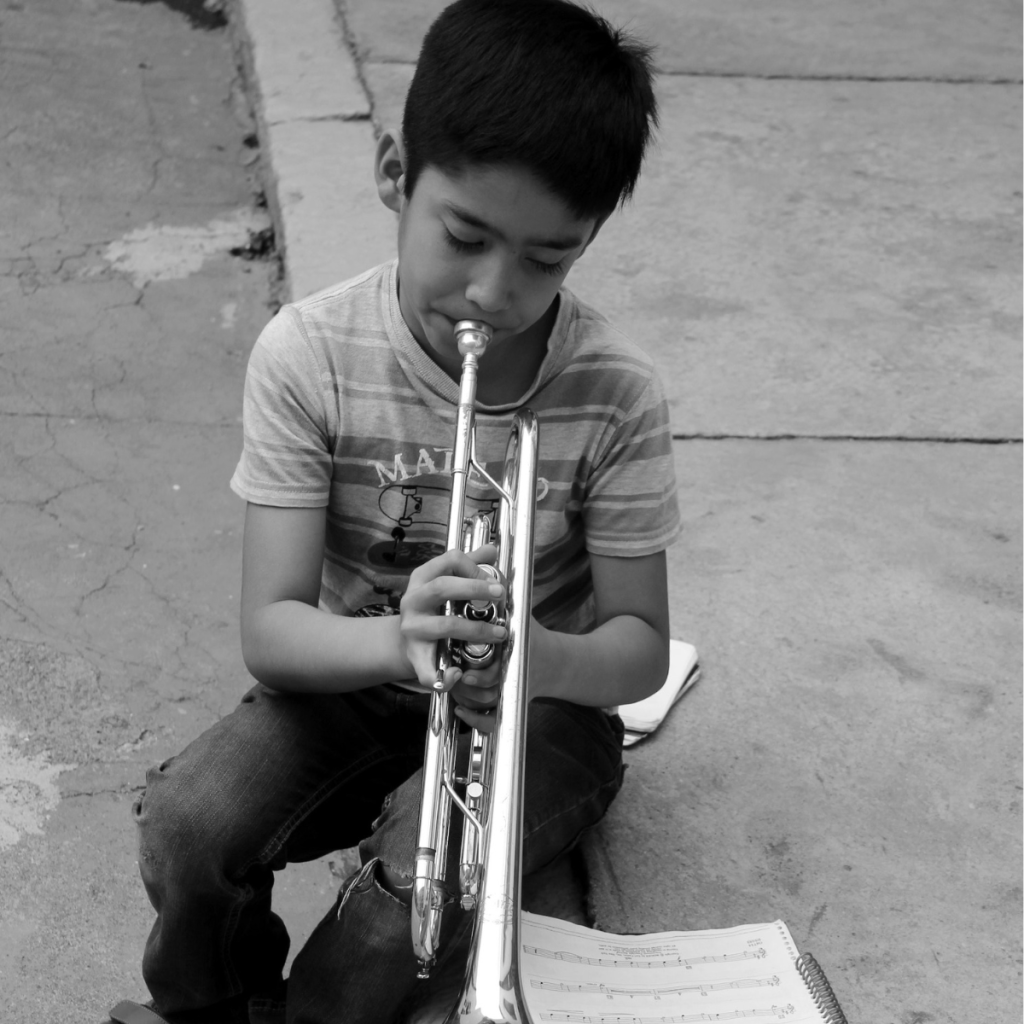Discover a comprehensive step-by-step guide on how to effectively teach a musical instrument to a 7-8 year old child.
Teaching an Instrument to a 7-8 Year Old Child: A Step-by-Step Guide
As parents, we want to provide our children with every opportunity to grow and thrive. One way we can do this is by introducing them to the magical world of music. Teaching an instrument to a 7-8 year old child can be a rewarding and enriching experience for both the child and the caregiver. In this step-by-step guide, we will explore the intricacies of this process and provide you with valuable insights and tips to make it a fun and engaging adventure.
Understanding the Cognitive Abilities of 7-8 Year Olds

Before embarking on this musical journey, it is important to understand the cognitive abilities of 7-8 year olds. At this age, children have developed a higher level of reasoning and problem-solving skills. They are curious and eager to explore new things. Their attention spans are increasing, making it easier for them to focus on tasks for longer periods.
Additionally, their memory skills have improved, allowing them to retain and recall information more effectively. This is especially beneficial when it comes to learning and memorizing musical notes and rhythms. Their language skills are also more advanced at this age, allowing children to comprehend and follow instructions more effectively.
Furthermore, their motor skills have developed to a point where they can handle fine movements required to play musical instruments. Whether it’s pressing the keys on a piano, strumming the strings of a guitar, or holding a bow to play the violin, their dexterity and coordination have reached a level where they can engage with various instruments confidently.
It is important to note that every child is unique, and their cognitive abilities may vary. Some children may excel in certain areas, while others may struggle. As an instructor, it is crucial to tailor your teaching approach to their individual abilities and interests, providing them with the necessary support and guidance to thrive in their musical journey.
The Role of Music in Child Development
We all know that music has a profound impact on our emotions and overall well-being. For young children, music plays a crucial role in their development. Research has shown that learning and playing a musical instrument can enhance cognitive skills, improve academic performance, and foster creativity and self-expression.
Playing an instrument requires concentration, discipline, and perseverance. These valuable life skills can transfer to other areas of a child’s life, helping them excel academically and socially. Moreover, music provides an outlet for self-expression and offers a sense of accomplishment and self-confidence.
Furthermore, music has been found to have a positive effect on emotional development. It can help children regulate their emotions, express themselves in a safe and constructive manner, and develop empathy and compassion towards others. Through music, children can explore and understand a wide range of emotions, fostering emotional intelligence and resilience.
Additionally, music can also improve cognitive abilities such as memory, attention, and problem-solving skills. Learning to read musical notes and rhythms requires concentration and mental agility. It challenges the brain to process information in a unique way, strengthening neural connections and enhancing cognitive functioning.
Choosing the Right Instrument for Your Child
When it comes to choosing the right instrument for your child, it’s essential to consider their interests, physical abilities, and personal preferences. Allow them to explore different instruments and observe which ones capture their attention and curiosity.
Some children may be drawn to the melodic sounds of the piano, while others may be fascinated by the versatility of the guitar. Encourage your child to try out different instruments, such as the violin, flute, or even the drums. Each instrument offers a unique experience and challenges, allowing your child to discover their own musical path.
It is also important to consider your child’s physical abilities. For instance, if your child has small hands, they may find it easier to handle a smaller instrument, such as a ukulele or a recorder. On the other hand, if your child has a strong sense of rhythm and enjoys physical movement, percussion instruments like the drums may be a great fit.
Ultimately, the instrument they choose should align with their passion and enthusiasm, as this will greatly contribute to their motivation and continued interest in learning. Encourage them to attend concerts or watch performances of different instruments to further inspire and ignite their musical curiosity.
Remember, the journey of learning a musical instrument is a lifelong adventure. By providing your child with the opportunity to explore and engage with music at a young age, you are nurturing their creativity, cognitive abilities, and emotional well-being, setting them on a path of self-discovery and personal growth.
Preparing for the First Lesson
Now that you have chosen the perfect instrument for your child, it’s time to prepare for their first lesson. This is an exciting milestone that will set the tone for their musical journey. By creating a positive and conducive learning environment, you can help your child develop a lifelong love for music.
Before diving into the first lesson, it’s important to set up a practice space that will inspire and motivate your child. Designating a dedicated area solely for practicing will help create a focused and productive learning environment. Consider transforming a corner of their room or a small nook in your home into a musical oasis.
Setting Up a Practice Space
When setting up the practice space, ensure that it is well-lit and free from distractions. Natural light can enhance the mood and create a welcoming atmosphere. If natural light is limited, invest in a good quality desk lamp or overhead light to illuminate the area.
Next, arrange your child’s instrument in a comfortable and easily accessible manner. Whether it’s a piano, guitar, or violin, make sure it is within reach and properly positioned. This will allow your child to focus on playing without any unnecessary strain or discomfort.
To make the practice space even more inviting and appealing, consider adding some personal touches. Hang up inspiring posters of famous musicians or decorate the walls with musical notes and symbols. Display their favorite sheet music or musical paraphernalia to ignite their enthusiasm and creativity.
Additionally, providing a comfortable chair or cushion for your child to sit on while practicing is crucial. Consider the ergonomics of their position while playing the instrument. Proper posture and comfort are key to preventing physical discomfort and developing good playing habits.
Establishing a Practice Routine
Now that the practice space is set up, it’s time to establish a practice routine that works for both you and your child. A consistent practice schedule is paramount to your child’s progress and enjoyment of playing an instrument.
Work with your child to establish a schedule that suits their daily routine. Consider their school hours, extracurricular activities, and other commitments. By involving them in the decision-making process, they will feel a sense of ownership and responsibility towards their practice sessions.
Ideally, aim for short and frequent practice sessions rather than longer, sporadic ones. Breaking the practice sessions into manageable time intervals will prevent your child from feeling overwhelmed. It’s better to have several focused 15-minute sessions throughout the week than one hour-long session where their attention may waver.
During practice sessions, offer positive reinforcement and rewards to motivate your child to stay on track. Celebrate their achievements, no matter how small, and encourage them to keep pushing forward. Remember, the ultimate goal is to make the learning process enjoyable, so adapt the routine as needed to keep it engaging and fun.
By creating a well-equipped practice space and establishing a consistent routine, you are setting the stage for your child’s musical journey. With your support and guidance, they will develop the necessary skills and passion to become a lifelong musician.
Basic Music Theory for Kids
Understanding the basic principles of music theory is fundamental for any budding musician. By introducing your child to these concepts in a playful and interactive way, you can lay a solid foundation for their musical journey.

Introducing Musical Notes and Scales
Begin by teaching your child about musical notes and scales. Demonstrate the different note values, such as whole notes, half notes, and quarter notes. Use visual aids or flashcards to make the learning process more engaging and memorable.
Gradually introduce them to scales and help them understand how melodies are created by combining different notes. Encourage them to experiment with different scales and melodies on their instrument, fostering their creativity and musical exploration.
Understanding Rhythm and Tempo
Rhythm and tempo are essential elements of music that require a deeper understanding. Teach your child about the different time signatures, such as 4/4 or 3/4, and help them develop a sense of timing and rhythm.
Engage them in interactive rhythm exercises, such as clapping or tapping along to a metronome. Play rhythmic patterns on their instrument together, gradually increasing the complexity as they progress. This playful approach will help them internalize and apply rhythm and tempo concepts in their playing.
Making the Learning Process Fun and Engaging
Learning an instrument should never be a dull or tedious task. By infusing fun and creativity into the process, you can keep your child motivated and excited about their musical journey.
Incorporating Games into Lessons
Games are a fantastic way to make learning enjoyable and interactive. Integrate musical games into your child’s lessons to reinforce concepts and provide them with a sense of achievement.
For example, create a treasure hunt where they have to locate and play certain notes or musical patterns. Use dice or cards to determine the order of notes they need to play. The possibilities are endless, so let your imagination run wild and make each lesson an adventure they eagerly look forward to.
Using Songs to Teach Musical Concepts
Utilize popular songs or melodies to teach your child important musical concepts. By incorporating familiar tunes, you make learning more relatable and enjoyable.
Choose songs that align with their musical interests and use them as a platform to introduce new techniques or theory. Break the songs down into smaller sections, ensuring your child understands each component before putting it all together. Sing along or play the songs together, creating a harmonious and enjoyable experience for both of you.
Dealing with Challenges and Frustrations
Learning an instrument can be challenging at times, and it’s essential to support your child through the ups and downs of this journey.
Encouraging Persistence and Patience
Learning any new skill requires persistence and patience. Teach your child the value of perseverance and encourage them to embrace challenges as opportunities for growth. Celebrate their small victories and milestones, and remind them that progress takes time.
Be a compassionate and supportive cheerleader, offering words of encouragement and reassurance when frustration sets in. Remind them that setbacks are part of the learning process, and with dedication and practice, they will overcome any obstacles they encounter.
Addressing Common Difficulties in Learning an Instrument
It’s not uncommon for children to face certain difficulties while learning an instrument. Be proactive in identifying and addressing these challenges.
For example, if your child is struggling with finger coordination, incorporate finger exercises and games into their practice routine. If they are having trouble reading sheet music, break it down into smaller, more manageable sections. Tailor your approach to suit their individual needs, ensuring that the learning experience remains enjoyable and nurturing.
Teaching an instrument to a 7-8 year old child is a remarkable gift that can ignite their passion for music and foster valuable life skills. Embrace this journey with enthusiasm, and remember to adapt and tailor your approach to suit your child’s unique learning style and interests. With patience, creativity, and a playful attitude, you can create a musical experience that will ignite their imagination and lay a solid foundation for their future musical endeavors.



